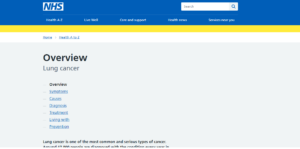
National Health Service UK – Lung Cancer (EN)
Malignant growths in the lungs are what is commonly known as lung cancer or lung carcinoma. There are two types of lung cancer: non-small cell lung cancer (NSCLC) and small cell lung cancer (SCLC). SCLC, sometimes also called oat cell cancer, presents tumorous cells that are smaller than normal lung cells. This is a relatively aggressive cancer type that tends to spread through the body.
SCLC makes up around 15% of all lung cancers in Belgium. Lung cancer is one of the most prevalent cancers in Belgium, being third for women and second for men. SCLC is most often found in patients over the age of 60. The outlook is not very good: of all patients that are diagnosed with a stage I SCLC only 36% are still alive after five years, and this percentage drops to 2% in patients who are diagnosed in stage IV.
The lungs are positioned on either side of the heart and consist of elastic sponge-like tissue. The right lung consists of three lobes, the left one of two. The lungs are enrobed in the pulmonary membrane. The lungs are the organs through which we breathe. The wind pipe splits into two branches known as the bronchi, and these in turn branch into the alveoli, where oxygen is passed on to the bloodstream.
Because SCLC only develops symptoms at a late stage, diagnosis also occurs fairly late, which accounts for the low survival rates. Symptoms depend on location, size and spread of the tumour. In general, tumours in the upper part of the lungs will cause earlier symptoms than cancers that develop deeper inside the lungs.
Possible warning signs include:
Other symptoms include:
It is impossible to pinpoint the exact origin of small cell lung cancer, but there is a correlation between SCLC and certain habits or environmental factors.
About one quarter of all lung cancer patients has never smoked tobacco. This group of patients often have mutated tumours, which point to changes in the DNA. Patients with this type of cancer have a better outlook than patients who have smoked.
Upon suspicion of possible lung cancer, a GP will refer a patient to a pulmonary specialist who will conduct further tests. These include lung X-rays, CT scans, FDG-PET scans, bronchoscopy, lung function tests, lung biopsy, diagnostic thoracotomy or VATS.
In a bronchoscopy, a flexible tube with a nano-camera is introduced into the windpipe via the nose or mouth. Diagnostic thoracotomy or VATS involves keyhole surgery during which a biopsy may take place.
As soon as a diagnosis of SCLC has been reached, further tests determine the advancement stage of the cancer. These tests include: MRI scans, perfusion scans, endo-ultrasound of the oesophagus, mediastinoscopy, PET scans, thoracoscopy, bone scans, pleural puncture and abdominal ultrasound.
Mediastinoscopy and thoracoscopy are forms of keyhole surgery under general anaesthetic. A pleural puncture involves draining and examining lung fluid from between the pulmonary membranes.
In order to come up with the best possible therapy, it is vital that the exact stage of advancement of the cancer is determined. For this, the TNM classification system is used. T stands for the state of the primary tumour, N denotes the amount of spreading to the lymph nodes and M stands for metastasis to other organs.
Small cell lung cancer (unlike non-small cell lung cancer) is divided into two further stages: limited and extensive. Roughly 60 to 70% of people have extensive disease at the time of diagnosis. Extensive stage SCLC is defined as a SCLC that has spread to other regions of the body such as another lobe of the lung or the brain
Often, SCLC is detected in a late stage, when metastasis has already occurred. In around 70 to 80% of all SCLC patients, palliative care is the only option since survival is no longer deemed possible. Chemotherapy, radiotherapy and endobronchial therapy are generally offered, sometimes in combination. Chemotherapy tends to be the most effective in treating SCLC. Only if the cancer is found at an early stage, can surgery be an option, in which part of the lung is removed. Immunotherapy and targeted therapy with PD-L1 inhibitors is an option for eligible patients. Research into CTLA-4, PD-L1, PARP and kinase inhibitors are under current investigation.





